Dogs
Low Maintenance Dog Breeds | You Need To Know These Dog Breeds

Low Maintenance Dog Breeds | You Need To Know These Dog Breeds
Are you looking for a dog that requires less attention and care? We have chosen a number of breeds that are simple to care for and maintain (in one way or another).
After that, we gave each of them a ranking according to our “low maintenance” criteria.
Therefore, if you are a first-time dog owner or lead a busy life, you can use our ratings to pick a dog that suits your circumstances well.
What Do You Mean By “Low Maintenance”?
Before we get started, several questions need to be answered, such as “What exactly is minimal maintenance?” and “Are you looking for a dog that is easy to train?” That doesn’t release any fibers?
Excellent with children and suitable for older people? A canine that is unproductive and would rather lie about all day? Or is it a combination of all of these things?
We know that the phrase “low maintenance” can have various connotations depending on the person. We’ve given each breed a score based on all these characteristics so that you can make a more informed choice.
There Is Always An Exception To A Rule!
These aren’t strict regulations; think of our ratings more as recommendations. There will always be exceptions, and it varies depending on the dog in question.
For instance, you’ll likely wind up with a dog that’s supposed to be relatively passive but instead turns out to be quite active.
There Is A Need For Training
You shouldn’t go into adopting a dog expecting minimal maintenance from the very first day. Training your dog to the point where you feel comfortable around them will require some time and work.
But once you and your dog have established a pattern, you can be sure that they will become more relaxed and appreciate the little things in life.
The Rating Methodology
A quick rundown on how each of these breeds fared in our evaluations follows.
Friendliness: This is a wide grade that considers how these breeds behave around people and other canine companions.
Easy to Train: Their openness to new information is the sole criterion for determining whether they’re easy to train. While some dog breeds are naturally curious and eager to learn, others have a reputation for being more headstrong.
Good With Kids: Good With Kids determine how well they can adapt to the presence of children in their own homes. A low grade indicates that these canines do not get along with children.
Easy to Groom: Will your dog require a lot of brushing? That’s the question posed by Easy to Groom. Keep in mind that different breeds (and varieties of hair) have specific requirements for their maintenance.
Energy Level: Your dog’s energy level is determined by how active or passive he is. A rating of five stars indicates that this dog is constantly eager to engage in play. A grade of one star indicates that this is a sluggish dog breed. Remember that most puppies are active until they reach full maturity.
Can Be Left Alone: Dogs are social animals; almost without exception, they do not enjoy being alone for any length of time. It is highly advised that you do not get a dog if you frequently spend a significant amount of time away from home. Alternatively, you may find someone to care for them in your absence.
Low Maintenace Dogs
Bedlington Terrier

This Bedlington Terrier, like its other Terrier relatives, was initially developed for hunting.
These dogs are fearless and make good watchdogs, even though they wear the clothes of lambs. Because they are members of the Terrier family, they also have a powerful instinct to hunt prey.
Therefore, a modest amount of daily exercise can significantly improve Bedlington. The last thing that you want is for your Terrier to be bored since they could resort to destructive behaviors like digging, barking, or chewing. T
Bedlington terriers are exceptionally bright canines, yet they can be pretty headstrong sometimes. Keep your cool, and remember that the most effective strategy in this situation is positive training because kids are susceptible to being reprimanded.
|
Friendly |
|
|
Easy to Train |
|
|
Good with Kids |
|
|
Easy to Groom |
|
|
Energy Level |
|
|
Can Be Left Alone |
|
Cavalier King Charles Spaniel

The Cavalier is a loving dog that wants to show its affection to everyone in its vicinity. They have a contagious, happy attitude that makes it difficult to maintain composure while they are around.
Because of their great intelligence, these dogs are ready to acquire new skills as long as they have a good treat in store for them. However, because of their placid demeanor, if you yell at or correct this dog, it will flee and hide from you.
Due to their inability to stand by themselves for extended periods of time, cavaliers are sometimes known as “Velcro” dogs. Take into consideration taking this dog on travels, or make sure they have a companion at home.
|
Friendly |
|
|
Easy to Train |
|
|
Good with Kids |
|
|
Easy to Groom |
|
|
Energy Level |
|
|
Can Be Left Alone |
|
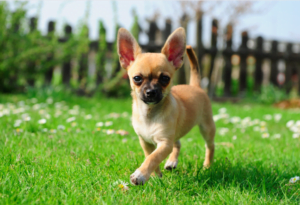
Chihuahuas make fantastic companions and are always eager to participate in whatever activities you have scheduled for the day. Chihuahuas are the definition of “Velcro” dogs since they are delighted to remain by your side at all times.
You must have someone keep this dog company nearly all of the time because leaving them alone might result in destructive behaviors such as chewing and barking brought on by boredom.
Chihuahuas have a surprising amount of energy to expend, despite their little legs, and a walk that lasts for at least half an hour can help correct undesirable behaviors. It is crucial to remember that they are highly susceptible to both hot and cold conditions.
|
Friendly |
|
|
Easy to Train |
|
|
Good with Kids |
|
|
Easy to Groom |
|
|
Energy Level |
|
|
Can Be Left Alone |
|
Dachshund
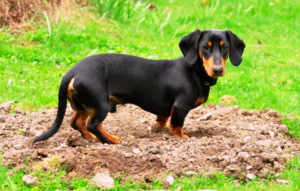
Dachshunds are adorable little bundles of pleasure who spend their days running around, playing, and occasionally dozing off. As long as they spend time with the people they care about, they can easily adjust to virtually any typical family activity.
Although they are pretty tiny, these dogs nonetheless enjoy roughhousing and can have personalities that are much larger than their actual size.
Dachshunds are also known for being watchful and curious, and they may want to make a sound whenever something catches their attention.
These toy dogs have an exceptionally high level of intelligence and are receptive to being trained. The intransigence of children causes problems, which are abundantly clear during potty training.
There is a wide selection of colors, patterns, and styles of coats available for dachshunds to pick from.
|
Friendly |
|
|
Easy to Train |
|
|
Good with Kids |
|
|
Easy to Groom |
|
|
Energy Level |
|
|
Can Be Left Alone |
|
French Bulldog

No other breed of dog can compare to a French bulldog. Their one-of-a-kind ears are shaped like bats, as are their enormous square heads, not to mention their goofy personalities.
Wrinkly, friendly, and inquisitive are just a few characteristics that describe French Bulldogs. They are skilled at establishing new friendships and integrating seamlessly into household life.
They don’t bark very often, but when they are enthusiastic or annoyed, they tend to grunt.
Because of their flat faces, individuals frequently experience breathing difficulties. It is important to avoid overexerting oneself and exposing oneself to excessive heat.
In addition, French bulldogs frequently experience health problems that necessitate frequent trips to the veterinarian (which could be costly).
|
Friendly |
|
|
Easy to Train |
|
|
Good with Kids |
|
|
Easy to Groom |
|
|
Energy Level |
|
|
Can Be Left Alone |
|
Havanese

The Havanese has the biggest heart of all the dogs, and the only thing on its mind is you. It is completely focused on you. But because they are so attached to their owners, Havanese dogs do not enjoy being alone.
Early socialization is essential if you don’t want your dog to be highly skittish as an adult. Even though training these dogs could be a slow process, it is crucial to stop excessive barking and other undesirable behaviors.
Even though the Havanese is known as a breed of dog that does not shed, regular brushing and other forms of maintenance are still necessary if you want to keep your pet free from uncomfortable mats.
|
Friendly |
|
|
Easy to Train |
|
|
Good with Kids |
|
|
Easy to Groom |
|
|
Energy Level |
|
|
Can Be Left Alone |
|
Italian Greyhound
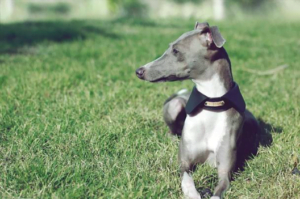
Like its larger Greyhound cousins, the Italian Greyhound is recognized for being a particularly athletic breed of dog. On the other hand, you might not anticipate that these dogs have a temperament that is so laid-back and kind.
Even while they enjoy a good run, their favorite parts of the day are nap time and getting cozy with their owners.
They still tend to be reserved around unfamiliar people and somewhat apprehensive when they are away from the security of their homes.
But with some early exposure to new people and experiences, they can learn to overcome their shyness and grow their self-confidence.
The process of training can be complicated at times, particularly when it comes to toilet training. On the other hand, these canines are susceptible to being reprimanded or receiving negative teaching.
|
Friendly |
|
|
Easy to Train |
|
|
Good with Kids |
|
|
Easy to Groom |
|
|
Energy Level |
|
|
Can Be Left Alone |
|
Maltese

The ideal way to characterize a Maltese would be as a lively and refined dog. A princess (or prince) appreciates the finer aspects of life, which frequently involve running, playing, and spending time with those who are dear to them.
The Maltese form strong bonds with their owners and usually do not like being left alone for long periods. In addition, they develop a protective instinct toward their owners, which causes them to be wary of strangers, youngsters, and even other dogs.
The Maltese is a breed of dog that is highly intelligent, simple to teach, and sheds very little hair. They like nothing more than lazing with their owners and taking long walks during the warm summer.
Their white and elegant hair must be cared for and maintained daily.
|
Friendly |
|
|
Easy to Train |
|
|
Good with Kids |
|
|
Easy to Groom |
|
|
Energy Level |
|
|
Can Be Left Alone |
|
Miniature Schnauzer
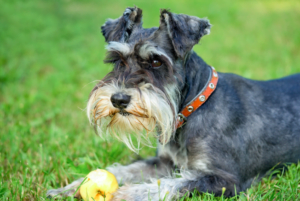
Schnauzers are known for having boundless amounts of energy and the largest hearts of any breed of dog.
You can expect this guy to jump off the wall with them since their passion and affection have no bounds, and there are no limits to what they can feel for one another.
Schnauzers have a natural talent for comedy and enjoy being the center of attention. They will put on a show for you and your friends if you let them.
The Schnauzer needs to engage in daily exercise; otherwise, they can try to relieve their boredom by engaging in destructive behaviors.
They are at the head of their class and, with a serene atmosphere, can acquire knowledge very rapidly. The Schnauzer need mental and physical stimulation and a strong desire to learn new things and discover their environment.
|
Friendly |
|
|
Easy to Train |
|
|
Good with Kids |
|
|
Easy to Groom |
|
|
Energy Level |
|
|
Can Be Left Alone |
|
Papillon

The Papillon is a dog that is always looking for fun because they are alert, full of energy, and constantly looking for its next great experience. These toy dogs have prominent personalities despite their diminutive stature and are not self-conscious about their size.
Because they require constant attention from their owners, the Papillon’s favorite activity is putting on a show for them. They do this because they expect it.
This little puppy is always doing something, whether running, jumping, playing, or licking your face. He’s always on the move. But we’re just kidding around here.
They are exceptionally eager learners, which allows them to excel at training and agility courses despite all of the activities and diversions they are exposed to.
|
Friendly |
|
|
Easy to Train |
|
|
Good with Kids |
|
|
Easy to Groom |
|
|
Energy Level |
|
|
Can Be Left Alone |
|
Pomeranian

A fluffy dog that is the star of its show, the Pomeranian can be overly cocky sometimes, but it’s all in good fun. The Pomeranian is the star of their show.
They are self-assured and curious and take pleasure in being accorded the status of a prince (or princess).
Because of their larger-than-life nature, you will need to set some ground rules to prevent them from thinking they are in charge of the entire establishment. In addition to this, they can be exceptionally difficult to housebreak and can bark excessively.
|
Friendly |
|
|
Easy to Train |
|
|
Good with Kids |
|
|
Easy to Groom |
|
|
Energy Level |
|
|
Can Be Left Alone |
|
Pug

Pugs are known as the “comedians of the canine world,” bringing a bit of their one-of-a-kind personality to every circumstance.
Although they are not actively looking for further mischief to get into, it is common knowledge that they are friendly, playful, and adventurous.
They are not the most active group, but they love getting out of the house daily for some exercise and playtime. Despite having a short coat, this small dog may shed quite a bit. You might be shocked by how much.
Their distinctive face form poses a few issues. It makes them breathe more rapidly, so you should brace your ears for a significant amount of snorting and wheezing.
It prevents them from correctly regulating their body temperature, which means that putting these dogs in either too hot or too cold might result in major health issues.
|
Friendly |
|
|
Easy to Train |
|
|
Good with Kids |
|
|
Easy to Groom |
|
|
Energy Level |
|
|
Can Be Left Alone |
|
Shih Tzu
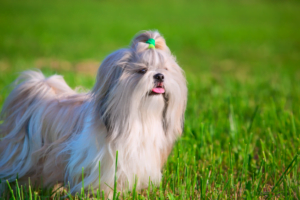
The Shih Tzu is a playful and affectionate dog that wants nothing more than to be a family member. This dog is the focus of attention at all times.
There is no evidence of hunting or herding instincts in Shih Tzus because this breed was developed specifically for companionship; thus, you won’t find any social characteristics in their genes.
Their pleasant demeanor makes them quite compatible with almost any environment; they get along well with children, families, and even other dogs; the more dogs there are, the better.
Shih Tzus thrive in households with other Shih Tzus because they keep each other entertained, which, strangely, results in less work for their owners.
|
Friendly |
|
|
Easy to Train |
|
|
Good with Kids |
|
|
Easy to Groom |
|
|
Energy Level |
|
|
Can Be Left Alone |
|
Toy Poodle

Poodles are considered among the most intellectual of all dog breeds, placing them at the head of their class. Poodles are intelligent dogs that thrive on being taught new things, and as a result, they require daily exercise lest they develop negative behaviors.
When they are young, they are full of activity and have a lot of “talking” to do. Additionally, they frequently look for trouble by digging and racing around.
They require a confident leader to establish themselves and set the rules, or they might try to do it themselves, which can lead to aggressive conduct.
They tend to become more peaceful as they get older, but they still require activities that engage both their body and mind. We strongly suggest investing in the appropriate brush for your poodle to avoid unnecessary stress.
|
Friendly |
|
|
Easy to Train |
|
|
Good with Kids |
|
|
Easy to Groom |
|
|
Energy Level |
|
|
Can Be Left Alone |
|
Whippet

These canines are a popular breed of racing dogs and were originally used for hunting rabbits. They are similar to greyhounds in appearance.
Because of their high athleticism and intelligence, Whippets perform exceptionally well in obedience and agility competitions.
But despite all that energy, these dogs are remarkably laid back and like to take naps when they get the chance. They have so much love to give and can make themselves at home in almost any environment.
Additionally, they do not produce a lot of noise, and the only time they are likely to do so is when they are left alone. In addition, its short coat requires minimal brushing and virtually no shedding.
|
Friendly |
|
|
Easy to Train |
|
|
Good with Kids |
|
|
Easy to Groom |
|
|
Energy Level |
|
|
Can Be Left Alone |
|
Yorkshire Terrier
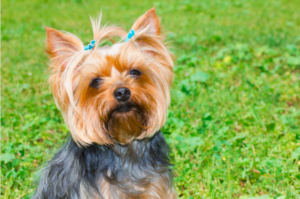
“Yorkies” believe they should be the focus of everyone’s attention because they are the stars of their show. They have a lot of personalities that they like to show off, and with that charm comes a certain amount of sass.
These dogs have a prey drive that is off the charts, a quality that was intentionally bred into them so that they could be used to hunt rodents in the past.
Yorkies are social dogs that thrive on human company and reward their owners with unending affection and unwavering devotion.
However, their owner is the one who loves them, and sometimes there is no room in that relationship for anybody else.
These canines sometimes behave cruelly toward other dogs, humans, and even other members of their own families. The Yorkie is an excellent choice for households that do not have children.
|
Friendly |
|
|
Easy to Train |
|
|
Good with Kids |
|
|
Easy to Groom |
|
|
Energy Level |
|
|
Can Be Left Alone |
|
Medium Sized But Require Low Maintenance
American Eskimo

The American Eskimo is a beautiful choice for a family pet since he is bright, friendly, and full of zest for life.
These dogs are active and curious, and they are always looking for new things to do each day; because of this, they require both a mental and a physical outlet from their owners.
These dogs cannot be left alone for extended periods since they will turn to destructive behaviors such as digging and barking.
The Eskimo dog is an intelligent and friendly breed that learns quickly and adapts well to a family’s lifestyle. They are lovely with kids, other animals, and even total strangers.
|
Friendly |
|
|
Easy to Train |
|
|
Good with Kids |
|
|
Easy to Groom |
|
|
Energy Level |
|
|
Can Be Left Alone |
|
Basset Hound

How could you possibly say no to those charming eyes and ears? The Basset Hound is a lovely addition to any family, although they can be a little headstrong and have a lot of humorous quirks in their personalities.
When it comes to training, they unquestionably require a small amount of persuasion. On the other hand, it is good to know that they are highly sensitive individuals who do not react favorably to being reprimanded.
The Basset Hound dog breed is known for being low maintenance because they would rather sleep in, laze around during the day, and only participate in a few quick bouts of fun.
The dog will still need to be walked daily, but if going for long runs isn’t your thing, this could be the perfect pet for you.
Bassets do not enjoy being left alone for extended periods; if they are, they will howl, which is a sound synonymous with the breed of dog known as the Basset Hound. They are also capable of making a lot of noise while playing and even while they are sleeping.
|
Friendly |
|
|
Easy to Train |
|
|
Good with Kids |
|
|
Easy to Groom |
|
|
Energy Level |
|
|
Can Be Left Alone |
|
Beagle

This adorable little package has all the qualities that contribute to a dog’s overall greatness. Beagles are devoted companions that are also friendly, rambunctious, and always up for an exciting new experience.
However, in their pursuit of new experiences, they frequently engage in undesirable behaviors. Because of this, they often require the company of a human or canine partner to satisfy their ongoing desire for attention.
Nothing is more heartbreaking than a lonely Beagle; thus, leaving this home alone will likely lead to irritating behaviors such as chewing, digging, or barking. There is nothing more heartbreaking than a lonely beagle.
Beagles need a significant amount of training from an early age in order to prevent them from engaging in inappropriate activities; otherwise, you run the risk of upsetting some of your neighbors.
These are beautiful dogs with large hearts, but the early training can sometimes be challenging and stressful. If you can get beyond that, you’ll find they have a lot of heart.
|
Friendly |
|
|
Easy to Train |
|
|
Good with Kids |
|
|
Easy to Groom |
|
|
Energy Level |
|
|
Can Be Left Alone |
|
Cocker Spaniel

The attitude of Cocker Spaniels are regarded as being kind and peaceful, but they are always eager for an exciting new adventure.
Because of their enormous hearts and brains, they are open to receiving constructive instruction and always prepared for a test of their mettle.
It is common for them to have a hesitant demeanor among new people and a tendency to bark excessively (mainly when left alone). Early intervention in the form of socialization and training can work wonders to modify such behaviors.
Additionally, Cocker Spaniels are well-known for having gorgeous coats that flow freely. However, there is always a price to pay for attractiveness, as you will need to brush their coat out daily and take them to a professional groomer once a month.
|
Friendly |
|
|
Easy to Train |
|
|
Good with Kids |
|
|
Easy to Groom |
|
|
Energy Level |
|
|
Can Be Left Alone |
|
Large Dogs That Require Low Maintenance
Bernese Mountain Dog

The Bernese Mountain Dog, sometimes known as a “Berner,” is, figuratively speaking, a gigantic comedian with a great heart. They go about their days with the sole intention of making other people laugh at their antics.
Despite their goofiness, they learn quickly and take direction well. They are completely enamored with doing things together as a family and desire nothing more than to participate in your daily adventures.
They will learn more and become a more contributing part of the family if they are treated with patience and given constructive training. A Bernese is a dog that has a lot of muscle.
They frequently weigh more than one hundred pounds, have a coat that must be brushed and groomed consistently, and cannot be left alone for extended periods. Because of this, they do not require little effort to maintain.
However, because of their strong desire to become a member of your family, they are easy to teach and make an excellent friend.
|
Friendly |
|
|
Easy to Train |
|
|
Good with Kids |
|
|
Easy to Groom |
|
|
Energy Level |
|
|
Can Be Left Alone |
|
Bullmastiff
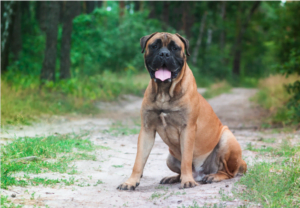
The Bullmastiff is a breed that tends to laze around the house. You can almost always find them sleeping or basking in the sun, although they are always game for a stroll.
They are unexpectedly one of the greatest big apartment dogs due to the relatively laid-back nature of their personality.
Because of their short coat, they are relatively simple to groom. Drooling is a further issue that might arise due to the jowls of the mastiff. There is so much saliva.
Because they are so resistant to being trained, this can also be a challenge. They demand an authoritative leader while also being fair, or they will fill that role themselves.
|
Friendly |
|
|
Easy to Train |
|
|
Good with Kids |
|
|
Easy to Groom |
|
|
Energy Level |
|
|
Can Be Left Alone |
|
Greyhound
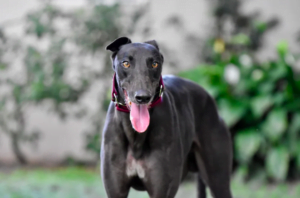
Having the world’s quickest dog as a pet would be quite a challenge to maintain. And despite requiring a great deal of physical activity, Greyhounds are actually very quiet and endearing pets.
They take pleasure in dozing off, basking in the sun’s warmth, and spending time with their loved ones during the day. They require very little attention and care.
Greyhounds only bark or create any other kind of noise when they are left alone for an extended amount of time. Because of their short coat, they typically do not emit any offensive odors. In addition to this, they are highly amenable to being trained.
They have the potential to be a very shy breed, and they might exhibit indications of anxiety when they are around unfamiliar people or other dogs.
Because of this, it is highly important that you expose them to new people and experiences at a young age so that they can gain some self-assurance.
|
Friendly |
|
|
Easy to Train |
|
|
Good with Kids |
|
|
Easy to Groom |
|
|
Energy Level |
|
|
Can Be Left Alone |
|
Newfoundland Dog

The Newfoundland is known for its laid-back disposition, yet they step up to the challenge when the situation calls for bravery. Numerous incredible accounts of these canines come to the aid of children, humans, or even other dogs under challenging circumstances.
The Newfoundland is more like a family member than a pet; they are innately protective of infants and display incredible devotion and adoration toward their masters.
These are enormous canines weighing an average of 140 pounds each. Because of their thick coat, which requires a lot of maintenance, you’ll need to brush them daily and take them to the groomer rather frequently.
Because they are well-behaved, friendly, and quick to pick up new skills, these dogs require very little attention and care. However, due to the sheer magnitude of their presence, they are not always easy to control.
|
Friendly |
|
|
Easy to Train |
|
|
Good with Kids |
|
|
Easy to Groom |
|
|
Energy Level |
|
|
Can Be Left Alone |
|
Standard Poodle
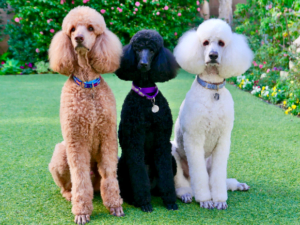
Possessing grace, athleticism, tenacity, and intelligence. These are some of the most admirable characteristics of the Standard Poodle breed.
And, as you’ve probably already been told, they have an astounding level of intelligence, which puts them at the top of their class.
These tough animals enjoy a little rough play and going on long walks, even though they appear to have a “dainty” appearance.
Because of the combination of their knowledge and their activity, they tend to quickly become bored and seek out mischief as a kind of release. They can maintain their happiness with a run or workout every day.
|
Friendly |
|
|
Easy to Train |
|
|
Good with Kids |
|
|
Easy to Groom |
|
|
Energy Level |
|
|
Can Be Left Alone |
|
Standard Schnauzer
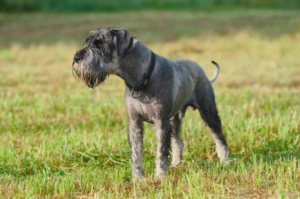
Schnauzers are known for having large hearts and boundless amounts of energy. Schnauzers are friendly and affectionate dogs whose main goal in life is to bring a smile to your face. Because of this, they make an excellent companion.
They have a passionate desire to please their owners and are highly trainable, which is why they frequently participate in activities like agility and hunting.
The Schnauzer needs to engage in daily exercise; else, they can try to relieve their boredom by engaging in destructive behaviors.
Because of their high level of intelligence and the fact that they are well aware of their intelligence, these dogs have the potential to be a breed that is both cunning and naughty.
|
Friendly |
|
|
Easy to Train |
|
|
Good with Kids |
|
|
Easy to Groom |
|
|
Energy Level |
|
|
Can Be Left Alone |
|
Labrador Retriever

The Labrador is a devoted, gentle, and enthusiastic companion who enjoys frolicking and playing with its human family. Get ready to make an immediate best friend for life by showing unconditional love and cuddling with them.
Because of their boundless enthusiasm and boundless energy, Labradors require strong leadership and a great deal of patience. To truly excel, they must engage in strenuous daily activity, take on challenging new tasks, and keep their minds stimulated.
A lab not being utilized to its full potential is extremely harmful. When one is left alone with excessive energy or an insufficient number of diversions, unpleasant behavior can result, typically in the form of chewing, barking, or digging.
Labradors are friendly, outgoing, and clever dogs who require little attention because they combine these traits. But you won’t have the option to miss going for a run every day, not even if it’s pouring rain or snowing outside.
|
Friendly |
|
|
Easy to Train |
|
|
Good with Kids |
|
|
Easy to Groom |
|
|
Energy Level |
|
|
Can Be Left Alone |
|
Golden Retriever

Golden Retrievers are eager to become your new closest companion from the moment you first look at them. It doesn’t take much effort to develop feelings for these canines.
Their sense of humor, charming demeanor, and enthusiasm for new experiences are incredibly infectious.
It should come as no surprise that Golden Retrievers are frequently chosen for work in the field of service dogs, given their high level of intelligence and calm demeanor.
Even though they are the perfect dog for many different households, they still need significant training and activity. These dogs require at least an hour’s worth of daily exercise because they are so full of exuberant energy that they bounce off the walls.
Because their pack is the most important thing in the world to a Golden Retriever, abandoning them will result in a heartbroken and destructive dog.
And lastly, that gorgeous coat demands a lot of maintenance; you’ll need to brush them out every day and take them to the groomer at least once in a while to keep them in tip-top shape.
|
Friendly |
|
|
Easy to Train |
|
|
Good with Kids |
|
|
Easy to Groom |
|
|
Energy Level |
|
|
Can Be Left Alone |
|
High Maintenance Dogs
Generally speaking, dogs that require a lot of attention and care are working and herding breeds, often known as dogs that were created to perform a task.
And owners who don’t have enough time to devote to their businesses could find satisfying their need to work challenging.
These dogs can, without a doubt, be fantastic additions to your household and can be properly trained to adapt to various settings. Be mindful that they could require additional time and patience to reach their destination.
Best Dogs For Living Apartments
The dogs that are best suited for living in condominiums and apartments are often low-energy, easy to housebreak, and do not generate much noise.
Using this list, you should not have too much trouble locating such information; however, what about the vast breeds?
There are certain large breeds of dogs that are well-suited for apartment living. The following items are included on our list:
- Bullmastiff
- Great Dane
- Greyhound
- Newfoundland
- Saint Bernard
We appreciate you for taking the time to read this article!
Finally, we hope you found this article interesting? And what do you think about ”Low Maintenance Dog Breeds | You Need To Know These Dog Breeds!?”
Please feel free to share or inform your friends about this article and this site, thanks!
And let us know if you observe something that isn’t quite right.
Dogs
Exploring the Diverse World of Dog Breeds: A Look at the Seven Main Groups + the others

Exploring the Diverse World of Dog Breeds: A Look at the Seven Main Groups + the others
Dogs are one of the most diverse species on the planet, with hundreds of different breeds that vary widely in size, shape, temperament, and behavior. To help organize this diversity, dog breeds are often grouped into categories based on their original purpose or characteristics.
These groups, recognized by kennel clubs and breed organizations worldwide, provide a framework for understanding the different types of dogs and their typical traits. Here are the main groups of dogs:
- Sporting Group: These dogs were bred for hunting game birds, both on land and in the water. They are known for their stamina, intelligence, and willingness to please. Breeds in this group include the Labrador Retriever, Golden Retriever, and English Springer Spaniel.
- Hound Group: Hounds are known for their keen sense of smell and ability to track prey. They are often used for hunting and tracking game. Breeds in this group include the Beagle, Bloodhound, and Greyhound.
- Working Group: Dogs in this group were bred for specific tasks, such as guarding property, pulling sleds, or performing water rescues. They are known for their strength, intelligence, and trainability. Breeds in this group include the Siberian Husky, Boxer, and Great Dane.
- Terrier Group: Terriers were originally bred to hunt and kill vermin. They are known for their feisty and energetic nature. Breeds in this group include the Jack Russell Terrier, Bull Terrier, and Scottish Terrier.
- Toy Group: Toy breeds are small companion dogs that were bred for their portable size and charming personalities. They are often kept as lap dogs or companions. Breeds in this group include the Chihuahua, Pomeranian, and Shih Tzu.
- Non-Sporting Group: This group is a diverse collection of breeds that don’t fit into other categories. They vary widely in size, coat type, and temperament. Breeds in this group include the Bulldog, Poodle, and Dalmatian.
- Herding Group: These dogs were bred to control the movement of other animals, such as sheep or cattle. They are known for their intelligence, agility, and strong herding instincts. Breeds in this group include the Border Collie, Australian Shepherd, and German Shepherd Dog.
Each group has its own unique characteristics and traits, but all dogs share a common bond with humans as loyal companions and working partners. Understanding these groups can help you choose a breed that fits your lifestyle and preferences.
Sporting Group
- American Water Spaniel
- Boykin Spaniel
- Chesapeake Bay Retriever
- Clumber Spaniel
- Curly-Coated Retriever
- English Setter
- Flat-Coated Retriever
- Gordon Setter
- Irish Red and White Setter
- Irish Setter
- Irish Water Spaniel
- Nova Scotia Duck Tolling Retriever
- Pointer
- Spinone Italiano
- Sussex Spaniel
- Vizsla
- Weimaraner
- Welsh Springer Spaniel
- Wirehaired Pointing Griffon
Hound Group
- Afghan Hound
- American English Coonhound
- American Foxhound
- Basenji
- Black and Tan Coonhound
- Borzoi
- Cirneco dell’Etna
- Finnish Spitz
- Grand Basset Griffon Vendéen
- Greyhound
- Harrier
- Ibizan Hound
- Norwegian Elkhound
- Otterhound
- Petit Basset Griffon Vendéen
- Pharaoh Hound
- Plott
- Portuguese Podengo
- Redbone Coonhound
- Rhodesian Ridgeback
- Saluki
- Scottish Deerhound
- Sloughi
- Treeing Walker Coonhound
- Whippet
Working Group
- Akita
- Alaskan Malamute
- Anatolian Shepherd Dog
- Bernese Mountain Dog
- Black Russian Terrier
- Boerboel
- Boxer
- Bullmastiff
- Cane Corso
- Dogo Argentino
- Dogue de Bordeaux
- Greater Swiss Mountain Dog
- Great Pyrenees
- Komondor
- Kuvasz
- Leonberger
- Mastiff
- Neapolitan Mastiff
- Newfoundland
- Rottweiler
- Samoyed
- Siberian Husky
- St. Bernard
- Tibetan Mastiff
Terrier Group
- Airedale Terrier
- American Staffordshire Terrier
- Australian Terrier
- Bedlington Terrier
- Border Terrier
- Bull Terrier
- Cairn Terrier
- Cesky Terrier
- Dandie Dinmont Terrier
- Glen of Imaal Terrier
- Irish Terrier
- Kerry Blue Terrier
- Lakeland Terrier
- Manchester Terrier
- Miniature Bull Terrier
- Miniature Schnauzer
- Norfolk Terrier
- Norwich Terrier
- Parson Russell Terrier
- Russell Terrier
- Scottish Terrier
- Sealyham Terrier
- Skye Terrier
- Smooth Fox Terrier
- Soft Coated Wheaten Terrier
- Staffordshire Bull Terrier
- Welsh Terrier
- West Highland White Terrier
- Wire Fox Terrier
Toy Group
- Affenpinscher
- Brussels Griffon
- Cavalier King Charles Spaniel
- Chihuahua
- Chinese Crested
- English Toy Spaniel
- Havanese
- Italian Greyhound
- Japanese Chin
- Maltese
- Manchester Terrier (Toy)
- Miniature Pinscher
- Papillon
- Pekingese
- Pomeranian
- Poodle (Toy)
- Pug
- Shih Tzu
- Silky Terrier
- Toy Fox Terrier
- Yorkshire Terrier
Non-Sporting Group
- American Eskimo Dog
- Bichon Frise
- Boston Terrier
- Bulldog
- Chinese Shar-Pei
- Chow Chow
- Dalmatian
- Finnish Spitz
- French Bulldog
- Keeshond
- Lhasa Apso
- Lowchen
- Norwegian Lundehund
- Poodle (Miniature)
- Schipperke
- Shiba Inu
- Tibetan Spaniel
- Tibetan Terrier
- Xoloitzcuintli
Herding Group
- Australian Cattle Dog
- Australian Shepherd
- Bearded Collie
- Belgian Malinois
- Belgian Sheepdog
- Belgian Tervuren
- Border Collie
- Bouvier des Flandres
- Briard
- Canaan Dog
- Cardigan Welsh Corgi
- Collie (Rough)
- Collie (Smooth)
- German Shepherd Dog
- Icelandic Sheepdog
- Miniature American Shepherd
- Norwegian Buhund
- Old English Sheepdog
- Pembroke Welsh Corgi
- Polish Lowland Sheepdog
- Puli
- Pyrenean Shepherd
- Shetland Sheepdog
- Spanish Water Dog
- Swedish Vallhund
Miscellaneous Class
- American Hairless Terrier
- Barbet
- Biewer Terrier
- Boerboel
- Coton de Tulear
- Czechoslovakian Vlcak
- Lagotto Romagnolo
- Mudi
- Nederlandse Kooikerhondje
- Peruvian Inca Orchid
- Portuguese Podengo
- Rat Terrier
- Russian Toy
- Sloughi
- Thai Ridgeback
- Xoloitzcuintli
Rare Breeds
- Azawakh
- Bergamasco
- Chinook
- Cirneco dell’Etna
- Dandie Dinmont Terrier
- Finnish Lapphund
- Finnish Spitz
- Grand Basset Griffon Vendéen
- Kooikerhondje
- Lagotto Romagnolo
- Lowchen
- Norwegian Lundehund
- Otterhound
- Peruvian Inca Orchid
- Schipperke
- Sealyham Terrier
- Skye Terrier
- Sussex Spaniel
- Swedish Vallhund
- Tibetan Mastiff
Designer and Hybrid Breeds
- Labradoodle (Labrador Retriever + Poodle)
- Goldendoodle (Golden Retriever + Poodle)
- Cockapoo (Cocker Spaniel + Poodle)
- Pomsky (Pomeranian + Husky)
- Maltipoo (Maltese + Poodle)
- Cavapoo (Cavalier King Charles Spaniel + Poodle)
- Yorkipoo (Yorkshire Terrier + Poodle)
- Sheepadoodle (Old English Sheepdog + Poodle)
- Bernedoodle (Bernese Mountain Dog + Poodle)
- Aussiedoodle (Australian Shepherd + Poodle)
- Shih-Poo (Shih Tzu + Poodle)
- Boxerdoodle (Boxer + Poodle)
- Schnoodle (Schnauzer + Poodle)
- Chorkie (Chihuahua + Yorkshire Terrier)
- Puggle (Pug + Beagle)
- Cockapoo (Cocker Spaniel + Poodle)
- Labradoodle (Labrador Retriever + Poodle)
- Goldendoodle (Golden Retriever + Poodle)
- Cockapoo (Cocker Spaniel + Poodle)
- Pomsky (Pomeranian + Husky)
- Maltipoo (Maltese + Poodle)
- Cavapoo (Cavalier King Charles Spaniel + Poodle)
- Yorkipoo (Yorkshire Terrier + Poodle)
- Sheepadoodle (Old English Sheepdog + Poodle)
- Bernedoodle (Bernese Mountain Dog + Poodle)
- Aussiedoodle (Australian Shepherd + Poodle)
- Shih-Poo (Shih Tzu + Poodle)
- Boxerdoodle (Boxer + Poodle)
- Schnoodle (Schnauzer + Poodle)
- Chorkie (Chihuahua + Yorkshire Terrier)
- Puggle (Pug + Beagle)
Rare and Uncommon Breeds
- Bergamasco Shepherd
- Catahoula Leopard Dog
- Chinook
- Finnish Spitz
- Glen of Imaal Terrier
- Kooikerhondje
- Lagotto Romagnolo
- Mudi
- Otterhound
- Peruvian Inca Orchid
- Portuguese Podengo
- Pyrenean Shepherd
- Russian Toy
- Saluki
- Sloughi
- Swedish Vallhund
- Tibetan Mastiff
- Toy Fox Terrier
- Xoloitzcuintli
Conclusion
In conclusion, the world of dogs is incredibly diverse, with hundreds of breeds that vary widely in size, shape, temperament, and behavior. To help categorize this diversity, dog breeds are grouped into categories based on their original purpose or characteristics.
These groups, such as the Sporting Group, Hound Group, Working Group, Terrier Group, Toy Group, Non-Sporting Group, and Herding Group, provide a framework for understanding the different types of dogs and their typical traits.
Each group has its own unique characteristics and traits, but all dogs share a common bond with humans as loyal companions and working partners. Whether you’re looking for a hunting companion, a family pet, a working dog, or a lap dog, there’s a breed out there for everyone.
Understanding these groups can help you choose a breed that fits your lifestyle and preferences, ensuring a happy and fulfilling relationship between you and your canine companion.
Frequently Asked Questions (FAQs)
What are some breeds in the Sporting Group, and what are their typical characteristics?
Some breeds in the Sporting Group include the Labrador Retriever, Golden Retriever, and English Springer Spaniel. These breeds are known for their high energy levels, intelligence, and friendly nature. They are often used for hunting and retrieving game.
Which breeds are typically found in the Hound Group, and what sets them apart from other groups?
The Hound Group includes breeds such as the Beagle, Bloodhound, and Greyhound. Hounds are known for their keen sense of smell and ability to track prey. They are often used for hunting and tracking game.
What are some examples of breeds in the Working Group, and what are their common characteristics?
Breeds in the Working Group include the Siberian Husky, Boxer, and Great Dane. These dogs were bred for specific tasks, such as guarding property or pulling sleds. They are known for their strength, intelligence, and trainability.
Can you name a few breeds from the Terrier Group, and what makes them unique?
Terriers, such as the Jack Russell Terrier, Bull Terrier, and Scottish Terrier, were originally bred to hunt and kill vermin. They are known for their feisty nature and high energy levels.
What are some breeds in the Toy Group, and what role do they typically play in households?
The Toy Group includes breeds like the Chihuahua, Pomeranian, and Shih Tzu. These breeds are small in size and are often kept as lap dogs or companions. They are known for their portable size and charming personalities.
We appreciate you for taking the time to read this article!
Finally, we hope you found this article interesting? And what do you think about ”Exploring the Diverse World of Dog Breeds: A Look at the Seven Main Groups!?”
Please feel free to share or inform your friends about this article and this site, thanks!
And let us know if you observe something that isn’t quite right.
Dogs
Comprehensive List of Essential Whelping Kit Items

Comprehensive List of Essential Whelping Kit Items
If you’re just making your start as a dog breeder, you’ve likely got a lot of things on your mind. Finding a suitable mate for your dog, getting them tested—there’s a lot of mental and physical effort that goes into breeding responsibly. One way to make things easier for yourself is assembling your whelping kit early. A whelping kit contains all the necessary items to assist a mother dog during labour and ensure the safe delivery of her puppies.
For both experienced breeders and first-time pet owners, assembling a comprehensive whelping kit can make a significant difference in managing the birthing process. Having everything on-hand is a good idea, as you don’t want to suddenly be stuck without essential items in the midst of delivery.
Comprehensive List of Essential Whelping Kit Items
-
Whelping Box
The first and most crucial item is the whelping box. This is where the mother dog will give birth and care for her puppies during their first weeks of life. It should be spacious enough for the mother to move comfortably but with walls high enough to safely contain the newborn puppies.
-
Clean Towels and Blankets
You’ll need several clean towels to help dry puppies immediately after birth, which stimulates them to breathe and keeps them warm. Soft blankets can be used to line the whelping box for additional comfort.
-
Heating Pad or Heat Lamp
Maintaining a warm environment is essential, especially for newborn puppies who cannot regulate their body temperature. A heating pad or a heat lamp can provide the necessary warmth, but make sure it’s set up to avoid direct contact with the puppies and mother.
-
Digital Thermometer
To monitor the mother’s temperature leading up to labour, which can indicate when birth is imminent. A drop in body temperature is a common sign of labour starting within 24 hours.
-
Disposable Gloves
These are essential for hygiene. Wearing gloves during the delivery helps prevent the spread of infection and allows you to assist with the birth if necessary without introducing contaminants. You also don’t want to be touching anything else with dirty hands, so you may need to use multiple pairs of gloves if you have to operate your phone or move around any other items. Thankfully, a box of gloves is cheap and easy to come by.
-
Antiseptic Solution and Hand Sanitizer
Keeping your hands and the environment clean is crucial. An antiseptic solution can be used for cleaning any instruments or areas around the whelping box, while hand sanitizer should be used before and after assisting with the delivery.
-
Sterile Scissors and Dental Floss
In some cases, you may need to cut the umbilical cords. Sterile scissors are necessary for this task, and unwaxed dental floss can be used to tie off the cords before cutting to prevent bleeding.
-
Aspiration Bulb or Decongestant Syringe
To clear the puppies’ airways of mucus or fluids immediately after birth. It’s crucial for helping puppies who aren’t breathing well on their own initially.
-
Iodine Solution
After cutting the umbilical cord, applying iodine to the end helps prevent infection in the newborn puppy.
-
Puppy Feeding Kit
Includes bottles and appropriate puppy formula in case the mother is unable to nurse her puppies immediately or if there are rejected or weak puppies that need supplementary feeding.
Preparation and Storage Instructions
Organising the Kit
Arrange your whelping kit in order of likely usage. Items needed first, like gloves and towels, should be at the top or in the most accessible part of your storage container.
Storage
Keep the whelping kit in a clean, dry place that’s easily accessible during the whelping process. A portable, waterproof container with compartments can be ideal for quick access and organisation. It’s best to keep the kit in the same room where your dog will be staying, just so you don’t have to go looking for your kit once the time comes.
Preparation
Check and restock your kit well before the expected birthing date. Make sure all consumables are within their expiration date and that reusable items are clean and functional.
Troubleshooting Tips for Common Whelping Challenges
During the birthing process, several issues might arise that require immediate attention. Here are some troubleshooting tips for the most common challenges:
Stuck Puppy
If a puppy seems stuck, first ensure the mother is comfortable and not stressed. Wearing your disposable gloves, you can gently assist by providing mild traction on the puppy with a clean towel. If the puppy does not come free with gentle assistance, call your veterinarian immediately.
Weak Contractions
If the mother dog’s contractions seem weak and she’s having trouble delivering the puppies, a warm, sugar-water solution can help boost her energy. If there’s no improvement, it’s critical to contact your veterinarian, as she may need medication to strengthen contractions or even a caesarean section.
Non-responsive Puppy
If a puppy is not breathing or is too weak to nurse, stay calm. Use the decongestant syringe to clear its airways gently. Rubbing the puppy briskly with a towel can also stimulate breathing. If these methods don’t work, performing a safe puppy CPR and rushing the puppy to a vet is your next step.
Extra Useful Items
While the essentials will cover most situations, having a few additional items on hand can be beneficial:
- Nutritional Supplements for the Mother: Providing the mother with high-energy supplements or a high-calorie diet a few weeks before and after birth can help maintain her strength and improve milk production.
- Puppy Scale: To monitor the puppies’ weight daily, ensuring they are gaining weight and developing healthily.
- Record Keeping Materials: Keeping detailed records of each puppy’s birth time, weight at birth, and daily progress can be crucial, especially in large litters.
Conclusion
Preparing a comprehensive whelping kit and knowing how to use each item effectively can make the whelping easier not only on you, but also on your dog. The peace of mind that comes with knowing that you’re equipped with the right tools can be invaluable.
Remember, while a well-stocked whelping kit is crucial, nothing replaces the expertise of a qualified veterinarian during emergencies. Always have your vet’s number handy, and don’t hesitate to call if the situation becomes too difficult.
FAQs: Comprehensive List of Essential Whelping Kit Items
What is a whelping kit and why is it important?
A whelping kit is a collection of essential items needed to assist a dog during labor and the first few weeks of her puppies’ lives. It is crucial because it helps ensure the health and safety of both the mother and her puppies by providing the necessary tools and supplies to manage the birthing process and immediate postpartum care.
What are the most essential items to include in a whelping kit?
Key items to include in a whelping kit are:
- Whelping box: A clean, safe space for the mother to give birth.
- Clean towels: For drying the puppies and keeping the whelping area clean.
- Disposable gloves: To maintain hygiene during the birthing process.
- Scissors and umbilical clamps: For cutting and securing the umbilical cord.
- Bulb syringe: To clear mucus from the puppies’ airways.
How can I prepare for potential emergencies during whelping?
To prepare for emergencies, you should have:
- Contact information for a vet: In case of complications during birth.
- Puppy milk replacer and bottles: If the mother is unable to nurse.
- Heat source: Such as a heating pad or heat lamp to keep the puppies warm.
- Antiseptic solution: For cleaning any wounds or the umbilical cord area.
- Emergency medical supplies: Including a thermometer, stethoscope, and sterile gauze pads.
What items are necessary for post-whelping care?
For post-whelping care, you will need:
- Puppy scales: To monitor the puppies’ weight gain.
- Puppy ID collars: To identify and keep track of each puppy.
- High-quality puppy food: For when they start weaning.
- Cleaning supplies: Such as disinfectant and puppy pads to maintain a clean environment.
- Record-keeping materials: To document each puppy’s health and progress.
How often should I check on the puppies and mother after birth?
After birth, it is important to check on the puppies and mother frequently:
- First 24 hours: Monitor closely for signs of distress or complications.
- First week: Check every few hours to ensure the puppies are nursing well and gaining weight.
- After the first week: Regular checks multiple times a day to ensure continued health and proper development.
- Ongoing: Maintain a routine of daily health checks and keep the whelping area clean and comfortable.
We appreciate you for taking the time to read this article!
Finally, we hope you found this article interesting? And what do you think about ”Comprehensive List of Essential Whelping Kit Items!?”
Please feel free to share or inform your friends about this article and this site, thanks!
And let us know if you observe something that isn’t quite right.
Dogs
Understanding and Addressing Separation Anxiety in Dogs

Understanding and Addressing Separation Anxiety in Dogs
What is Separation Anxiety?
Separation anxiety is a common behavioral issue in dogs characterized by distress or anxiety when they are separated from their owners or left alone. This condition can manifest in various ways, including excessive barking, destructive behavior, pacing, panting, or even attempts to escape.
Causes of Separation Anxiety
Several factors can contribute to the development of separation anxiety in dogs, including:
- Past Trauma: Dogs that have experienced abandonment, neglect, or traumatic events in the past may be more prone to separation anxiety.
- Change in Routine: Changes in the dog’s routine or environment, such as moving to a new home or the absence of a family member, can trigger separation anxiety.
- Lack of Socialization: Dogs that have not been properly socialized or have not learned to cope with being alone may develop separation anxiety.
- Overdependence on the Owner: Dogs that are overly dependent on their owners for companionship and reassurance may struggle to cope with being alone.
Signs of Separation Anxiety
Recognizing the signs of separation anxiety is crucial for early intervention. Common signs include:
- Excessive barking or howling when left alone
- Destructive behavior, such as chewing furniture or scratching doors
- Pacing, restlessness, or excessive panting
- Urination or defecation inside the house, even if the dog is house-trained
- Attempts to escape or self-injury when confined
Tips for Helping Dogs Cope with Separation Anxiety
- Gradual Desensitization: Gradually acclimate your dog to being alone by leaving for short periods and gradually increasing the duration over time. Use positive reinforcement techniques, such as treats or toys, to create positive associations with alone time.
- Provide Enrichment: Keep your dog mentally and physically stimulated by providing interactive toys, puzzle feeders, or engaging in regular exercise. This can help alleviate boredom and anxiety.
- Create a Safe Space: Designate a comfortable and secure space for your dog to retreat to when you’re not home. This could be a crate, a cozy corner with their bed, or a room with their favorite toys.
- Establish a Routine: Stick to a consistent daily routine to provide structure and predictability for your dog. This can help reduce anxiety and create a sense of security.
- Seek Professional Help: If your dog’s separation anxiety persists despite your efforts, consider seeking guidance from a veterinarian or a certified animal behaviorist. They can provide personalized advice and assistance tailored to your dog’s specific needs.
Conclusion
Separation anxiety can be a challenging issue for both dogs and their owners, but with patience, understanding, and proactive intervention, it is possible to help your dog overcome their anxiety and lead a happier, more balanced life.
By recognizing the signs of separation anxiety, implementing positive reinforcement techniques, and seeking professional guidance when needed, you can support your dog in coping with being alone and strengthen your bond in the process.
FAQs (Frequently Asked Questions)
Can separation anxiety in dogs be cured?
While separation anxiety in dogs can be managed and improved with proper training and intervention, it may not be entirely cured in all cases. However, with patience, consistency, and appropriate support, many dogs can learn to cope better with being alone.
How long does it take to train a dog with separation anxiety?
The time it takes to train a dog with separation anxiety can vary depending on the severity of the anxiety, the dog’s temperament, and the effectiveness of the training methods used. Some dogs may show improvement within a few weeks, while others may require months of consistent training and behavior modification.
Are there medications available to treat separation anxiety in dogs?
In some cases, veterinarians may prescribe medications, such as anti-anxiety medications or antidepressants, to help manage severe cases of separation anxiety in dogs. These medications are typically used in conjunction with behavior modification techniques and should only be prescribed under the guidance of a veterinarian.
Can hiring a pet sitter or dog walker help with separation anxiety?
Hiring a pet sitter or dog walker can be beneficial for dogs with separation anxiety as it provides them with companionship and breaks up their time alone. However, it’s essential to ensure that the pet sitter or dog walker is experienced in handling dogs with separation anxiety and follows any specific instructions or routines provided by the owner.
Can older dogs develop separation anxiety?
Yes, older dogs can develop separation anxiety, particularly if they experience changes in their environment or routine, such as the loss of a companion or a change in living arrangements. It’s essential to monitor older dogs for signs of anxiety and provide appropriate support and intervention when needed.
-

 Pet Care2 years ago
Pet Care2 years agoThe Best Dog Collars For 2022
-

 Dogs2 years ago
Dogs2 years agoBichon Frise: The Happy, Playful, and Cuddly Companion
-

 Trending Pet Stories1 year ago
Trending Pet Stories1 year ago2023 ‘World’s Ugliest Dog’ Winner: Scooter’s Tale of Resilience
-

 Animals2 years ago
Animals2 years agoAre There Animals Having Down Syndrome?
-

 Pets2 years ago
Pets2 years agoThe Fascinating World Of The Red Chameleon
-

 Dogs2 years ago
Dogs2 years agoTop 10 Most Popular Dog Breeds According To AKC.
-

 Dogs2 years ago
Dogs2 years ago21 Dog Breeds That Resemble Bears Or Teddy Bears!
-

 Dogs2 years ago
Dogs2 years agoEskimo Dogs from Canada – What Are They? – Find Out!







